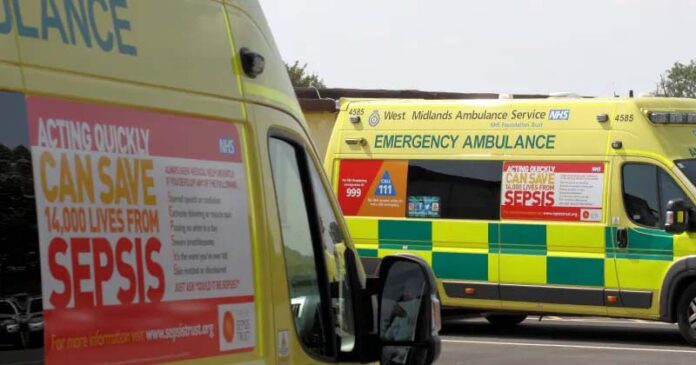Councillors have demanded a public inquiry into West Midlands Ambulance Service over the Staffordshire Moorlands not getting the same level of service as the rest of the West Midlands, with ambulance chiefs saying to do so would mean far more staff.
Councillors originally wanted an independent review but the strength of feeling was such that the councillors shifted their view and called for a public inquiry (writes local democracy reporter Jonathan Sutton).
Councillors at Staffordshire Moorlands District Council unanimously voted for the call for a public inquiry after agreeing that the Moorlands deserved the same quality of service as the rest of the West Midlands. The motion aimed to challenge the leadership of the ambulance service and not the frontline staff.
Introducing the motion, Coun Linda Malyon (Ind) told the council: “The reason I have put this notice of motion to full council is that I believe we in the Staffordshire Moorlands deserve the same quality of service as anywhere else in the West Midlands Ambulance area. As you know, this area covers a total of 5.6 million people and 5,000 square miles.
“It has now been downgraded to good and the county has at last set a working group up to look into it. This does not go far enough.”
West Midlands Ambulance Service hit back against the claims, stating it shared the concerns of the council but there was a correlation between ambulances being stuck at accident and emergency and ambulance waiting times.
The original motion read: “This council finds the West Midlands Ambulance Service, as it stands, unacceptable for the Staffordshire Moorlands. This council demands an independent review of the service.
“The residences of the Staffordshire Moorlands deserve the same reliable quality of service as people in the urban areas receive, meeting Government targets for everyone in rural and urban areas.”
Coun Mark Deaville said: “We deserve a reliable service in the Staffordshire Moorlands – and sadly we haven’t got one. Only a few years ago we had a service that we could be proud of, and we had a feeling of comfort that if we needed the 999 blue light service we’d get it and we’d get it very, very quickly.
“That is not that many years ago. We certainly haven’t got that now.”
Leader of the council Coun Mike Gledhill told the council chamber: “This is a really serious issue and it goes to the heart of when you rely on a regional organisation to give you a service and you are in a fairly remote part of that region, as we are in the Staffordshire Moorlands compared to the West Midlands.
“How do you get the service that is needed? Will the nature of that service be the same in Birmingham as it is in Ipstones? The answer is obvious, isn’t it? You can’t have a one size fits all approach.
“The worry about the situation at the minute is that in a really deep sense we don’t feel that the West Midlands Ambulance Service is responsive to the situation and needs of the Moorlands.”
A West Midlands Ambulance Service spokesman said: “The trust has been very clear that we share the concerns about the length of time it takes us to get to patients.
“There is a direct correlation between response times and hospital handover delays, something highlighted in the recent Care Quality Commission report into the trust. If our crews are left caring for patients outside hospital, they are not available to respond to the next call.
“This situation particularly impacts rural areas because ambulances would normally circulate through those areas. If they are stuck at A&E, that cannot happen and means crews often have to respond from the hospital, leading to extended response times.
“The second issue is rurality. The trust is not commissioned for individual postcode areas, only as a region. Research in Shropshire showed that to provide the same response times in rural areas as urban ones would require us to double our workforce and increase our fleet by two thirds.
“We will continue to work with our partners in health and social care to identify additional measures that can reduce hospital handover delays so that our ambulances can get to patients in the community much more quickly.”
Deaths
As we have reported, the service is also under more pressure to improve response times after it emerged that on two occasions, call handlers were unable to find the access code for a defibrillator when it was needed to save lives.
In December, the “Chronicle” reported how a reassurance was given that community defibrillators in Biddulph were checked regularly to make sure they were available for the public to use in an emergency.
This followed concerns raised by Brown Edge and Endon councillor Keith Flunder, who called for urgent action after he said the emergency control centre was unable to give accurate information about the location of the life-saving devices when needed.
He was referring to incidents in Ipstones when a defibrillator was required on two occasions to save the lives of people who suffered cardiac arrests; both died.
An investigation by West Midlands Ambulance Service found the call handler had intentionally closed down the defibrillator prompt on her screen and neither she nor the supervisor could retrieve the code. The investigation report said both had undergone extra training.
Eight months later, a man died following an incident with the same defibrillator.
An ambulance service investigation found the code should have been given to the person who dialled 999 before she left to get the defibrillator.
West Midlands Ambulance Service accepted there was a four-minute delay in accessing the code, which was again “missing in the notes.”
The service said refresher training had since been undertaken with all call assessors.
“This issue has now been rectified with a solution now implemented by our computer-aided dispatch system provider,” the service said.
It has also accepted its rural response times were poor, but said this was caused by handover hospital delays.
Pressure
Coun Gledhill has previously said the Moorlands “needs a better service” and has asked the chief executive to visit and talk about the concerns shared across the area’s political parties.
The authority has consulted with former and current ambulance service staff and believes paramedic response cars should be restored to rural areas and cited the two deaths in Ipstones.
County Coun Flunder, who also represents Biddulph South and Endon on the district council, has said that the county’s Health and Care Overview and Scrutiny Committee, on which he sits, was planning a visit to the ambulance service call centre in the wake of the defibrillator issues and a working group has been set up to find out more.
We also recently reported that ambulances had taken more than 1,000 more patients to Staffordshire A&Es in December compared to a year ago, increasing the pressure on staff.
Bosses were not sure why there were 1,011 more ambulance trips at the Royal Stoke and County Hospital, but said it would have “inevitably had an impact on emergency care”.
The trust board at University Hospitals of North Midlands was told that steps were being taken to reduce the number of attendances at emergency departments, to cut waiting times.
In December, 64.2% of A&E patients at University Hospitals of North Midlands NHS Trust were seen within four hours in December, compared to the national target of 76%. The number of 12-hour trolley waits fell from 1,175 in November to 1,053.
A report to the trust board said that while the overall number of A&E attendances had not increased in December, the rise in ambulance arrivals would probably “continue to pose a challenge”.





